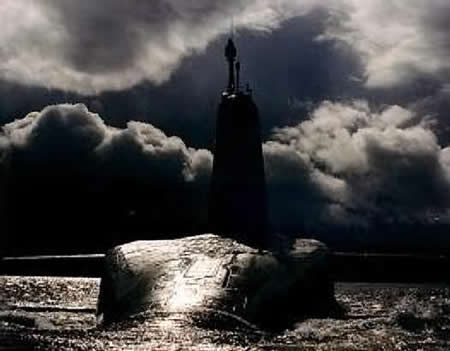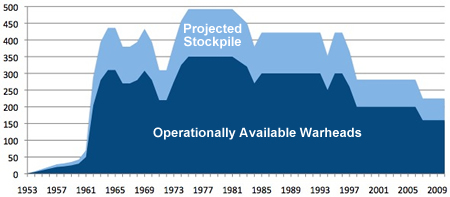Britain Discloses Size of Nuclear Stockpile: Who’s Next?
 |
| Britain says it has 225 nuclear warheads for its Trident submarine fleet. |
.
By Hans M. Kristensen
The new British government today followed the French and U.S. examples by disclosing its total military stockpile of nuclear weapons.
Foreign Secretary William Hague told the House of Commons that “the total number of warheads” in the “overall stockpile” will not exceed 225. Of those, “up to 160” are “operationally available” for deployment on Trident II missiles on British ballistic missile submarines.
The Royal Navy possesses four Vanguard-class nuclear-powered ballistic missile submarines (SSBNs), each of which can carry up to 16 U.S.-supplied Trident II long-range ballistic missiles. Each missile is thought to carry up to three UK-produced warheads closely resembling the U.S. 100-kt W76 warhead.
Stockpile and Arsenal
Whereas the United States declassified its entire stockpile history, the British government has only disclosed the current size of its stockpile, and only in the somewhat cryptic way: “the overall stockpile…will not exceed 225 warheads.”
That presumably means the stockpile actually contains 225 warheads, not that it might be smaller but “not exceed 225 warheads” even in the future.
That is 25 warheads more than the 200 Robert Norris and I have estimated in the past.
Of the 225 warheads, the government stated that it “will retain up to 160 operationally available warheads,” or as many as 71 percent of the entire inventory. There are only spaces for 144 warheads on Britain’s 50 Trident II SLBMs, of which 48 can be deployed on three operational SSBNs. The fourth boat is in refit at any given time and is not allocated missiles.
| British Nuclear Weapons Stockpile 2010 |
 |
| With the British government’s declaration, it’s possible to make an estimated breakdown of the categories of nuclear warheads in the British stockpile. |
.
The “up to 160” probably refers to the 144 spaces plus a small number of spare warheads. The number of spares might increase if an SSBN deploys with less than its maximum capacity of 48 warheads. The remaining 65 warheads in the stockpile are for what is described as “routine processing, maintenance and logistic management.”
It is not yet possible to plot the history of the British nuclear stockpile with certainty. But if one assumes that the ratio of warheads in the non-operational reserve to the operationally available inventory has been roughly the same as today (approximately 1 x 2.5), then a simplistic projection of the stockpile looks like this:
| British Nuclear Weapons Stockpile 1953-2010 |
 |
| The history of the British stockpile is unknown, but assuming the same percentage of warheads in reserve as today, a preliminary history can be plotted. |
.
The stockpile fluctuated considerably over the years with introduction and retirement of various weapon systems. The stockpile reached a peak in the late 1970s at nearly 500 warheads. After the Cold War, the stockpile decreased with the retirement of the WE-177 non-strategic nuclear bombs and depth charges for use by the air force and surface fleet. The last of the WE-177s was dismantled in August 1998.
Who’s Next?
Three of the five original nuclear weapon states have now disclosed the sizes of their military stockpiles of nuclear warheads. The pressure is increasing on the other nuclear weapon states to follow the good example.
The size of the Russian stockpile is unknown but Norris and I estimate Russia possesses 12,000 nuclear warheads, of which 4,600 might be operational. A Russian official recently told Reuters that Russia after ratification of the New START agreement “will likewise be able to consider disclosing the total number of Russia’s deployed strategic delivery vehicles and the warheads they can carry.” That would not be disclosing the size of the stockpile, but still be progress.
China’s stockpile is even more opaque, although Norris and I estimate it at approximately 240 warheads. That fits well with the declaration made by former British Defense Minister Des Browne in 2007, that the United Kingdom has “the smallest stockpile of any of the nuclear weapon states recognised under the NPT.”
Declarations from Indian and Pakistani would also be greatly welcomed. Israel is obviously a little more complicated because, well, it has yet to acknowledge that it has nuclear weapons, and North Korea doesn’t seem in the mood for goodwill gestures these days.
This publication was made possible by a grant from Carnegie Corporation of New York and Ploughshares Fund. The statements made and views expressed are solely the responsibility of the author.
Satellite imagery has long served as a tool for observing on-the-ground activity worldwide, and offers especially valuable insights into the operation, development, and physical features related to nuclear technology.
This report outlines a framework relying on “Cooperative Technical Means” for effective arms control verification based on remote sensing, avoiding on-site inspections but maintaining a level of transparency that allows for immediate detection of changes in nuclear posture or a significant build-up above agreed limits.
The grant comes from the Carnegie Corporation of New York (CCNY) to investigate, alongside The British American Security Information Council (BASIC), the associated impact on nuclear stability.
Satellite imagery of RAF Lakenheath reveals new construction of a security perimeter around ten protective aircraft shelters in the designated nuclear area, the latest measure in a series of upgrades as the base prepares for the ability to store U.S. nuclear weapons.